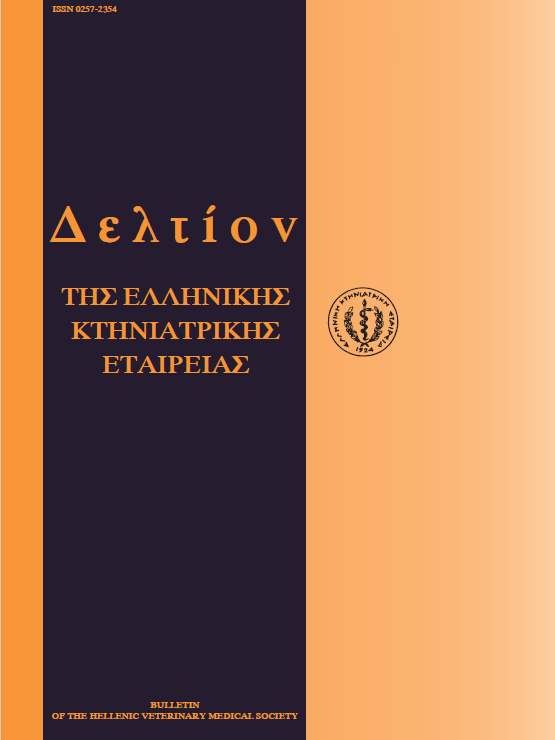Study of canine ringworm epidemiology in Thessaloniki area
Abstract
The presence of dermatophytes in animals with skin lesions (ringworm), as well as in animals with apparently healthy skin (healthy carriers) and in soil specimens was investigated. Skin scales and infected hair from 480 dogs with lesions were examined microscopically by using 20% KOH and by the methylene blue stain. Specimens were also inoculated in Sabouraud-chloramphenicolcycloheximide agar. Hairbrush technique was performed in 500 dogs with apparently healthy skin (330 of the urban and 170 of the rural area). 92 soil specimens were cultured by the hairbaiting method. Dermatophytes were isolated from 220 (40,8%) dogs with skin lesions. M. canis was isolated from the 87,7% of the dogs. M. gypseum from 7,2%, T. mentagrophytes from 4,5% and T. rubrum from 0,4%. Most of the infected animals (148) were up to 24 months old and 140 of them belonged to short coat breeds. From the 330 and the 170 apparently healthy dogs 38 (14,5%) and 35 (20,5%) were found carrying dermatophytes, respectively. M. canis was exclusively isolated from the dogs of the urban area. The most frequent dermatophyte isolated from the dogs of the rural area was M. gypseum, while T. terrestre and T. mentagrophytes were the second and the third isolated. From 30 soil specimens of the urban area and from 62 of the rural area, 25 (83%) and 56 (90,3%) strains of dermatophytes were isolated respectively. M. gypseum was the most frequent isolated of both areas. Representative dermatophytes, 2 strains of T. mentagrophytes and 2 of M. gypseum, isolated from the coat of animals with apparently healthy skin and from the soil proved to be pathogenic for laboratory animals. It is mentioned that M. canis implicated in public health because of its transmission to human and of the numerous cases of the animals owners affected.
Article Details
- Zitationsvorschlag
-
BOURDZI - HATZOPOULOU (Ε. ΜΠΟΥΡΤΖΗ - ΧΑΤΖΟΠΟΥΛΟΥ) E. (2018). Study of canine ringworm epidemiology in Thessaloniki area. Journal of the Hellenic Veterinary Medical Society, 48(2), 87–92. https://doi.org/10.12681/jhvms.15798
- Ausgabe
- Bd. 48 Nr. 2 (1997)
- Rubrik
- Research Articles

Dieses Werk steht unter der Lizenz Creative Commons Namensnennung - Nicht-kommerziell 4.0 International.
Authors who publish with this journal agree to the following terms:
· Authors retain copyright and grant the journal right of first publication with the work simultaneously licensed under a Creative Commons Attribution Non-Commercial License that allows others to share the work with an acknowledgement of the work's authorship and initial publication in this journal.
· Authors are able to enter into separate, additional contractual arrangements for the non-exclusive distribution of the journal's published version of the work (e.g. post it to an institutional repository or publish it in a book), with an acknowledgement of its initial publication in this journal.
· Authors are permitted and encouraged to post their work online (preferably in institutional repositories or on their website) prior to and during the submission process, as it can lead to productive exchanges, as well as earlier and greater citation of published work.



